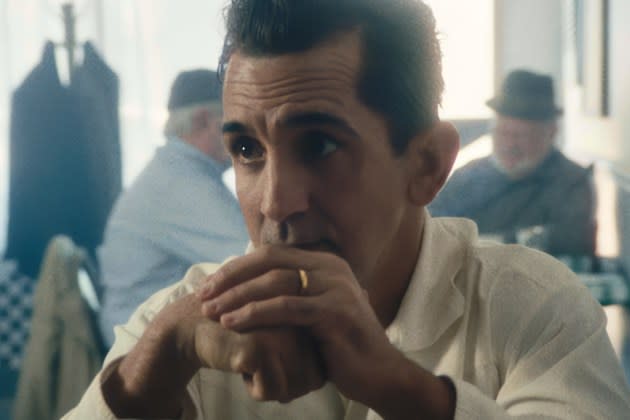‘The Featherweight’ Review: A Poetic Tribute to Boxing Champion Willie Pep
- Oops!Something went wrong.Please try again later.
- Oops!Something went wrong.Please try again later.

There’s a story that Willie Pep, the protagonist of Robert Kolodny’s feature debut The Featherweight, likes to tell. It’s about a match with a kid, who, so awed by the boxing champion, asks for an autograph. The request flummoxes Willie. “I say, ‘Kid, get away from me, we’re boxing tonight. What are people going to think?’” The crowd came to see a fight, he reminds the junior. They need to put on a show.
As Willie (played by James Madio) talks about this moment, he gesticulates and pulls his audience — a small group of friends — to play supporting roles. It’s clear why the boxer likes to recount this tale. Nostalgia tempts him. It directs his moods, prompts his long monologues and drives Willie, at age 42, to stage a comeback.
More from The Hollywood Reporter
The Featherweight is a fictionalized account of the real-life two-time featherweight champion’s attempts to get back in the ring. The Italian-American fighter, who died in 2006 at the age of 84, was considered by some experts to be one of the greatest pure boxers of all time. His movements were quick and lithe, like a dancer’s. His opponents struggled to pin him down. They called him “Will o’ the Wisp.”
Screenwriter Steve Loff frames the story as a documentary. Title cards inform us early that this fictionalized Willie invited a crew to capture his life on camera and to witness, in his mind, an inevitable success. The resulting movie is technically impressive, but occasionally emotionally arid: Featherweight indeed often gets so swept up in the details of crafting a documentary, in the many revelations of method, that its story can feel like an afterthought.
Kolodny’s experience in non-fiction — he worked on Laura Poitras’ All the Beauty and the Bloodshed and was the DP for Robert Greene’s Procession — positions him well for this project. Each frame of The Featherweight holds an understanding of the camera as a shape-shifting interlocutor. Willie submits to being watched with the hope of image control, but the spotlight is an unpredictable arena and the film gradually reveals this harshness.
The Featherweight opens with scenes of Willie in Connecticut. It’s 1964, four years after the boxing champion announced his retirement. The details of Willie’s life are bleak, despite his persistent, on-screen optimism. He’s in his fourth marriage, an odd union between him and Linda (an ace Ruby Wolf), a young aspiring actress. He’s accrued more debt from risky gambles than he’d like to acknowledge, and he meets frequently with his manager Bob (Ron Livingston) to negotiate auctioning off his prized possessions. His son, Billy (Keir Gilchrist), despises him. And Bill (Stephen Lang), the coach at his old boxing gym, doesn’t buy the comeback narrative.
In the face of stacked odds, Willie remains congenial, light and almost willfully obtuse. Can he detect the unhappiness in his wife’s voice when she hurls barbed comments in his direction? Does he sense the skepticism in responses to his comeback plan?
Kolodny and cinematographer Adam Kolodny rely on close-ups to build an intimate portrait of Willie, showing the boxer’s face seconds after his wife insults him or when he thinks no one is watching. In these moments, you can sense the toll life has taken and grasp a truer sense of Willie’s fraught emotional life. Madio’s strong performance helps clarify the mystery, too. His eyes, especially, reveal the character’s skittish, chronically nervous energy. They dart back and forth, always scanning rooms for an audience or competition. They become sullen when starved for attention. You can read the exhaustion on Willie’s face.
The Featherweight isn’t a traditional sports biopic, but its focus on an underappreciated figure may find an audience in those fans. Its narrative is subtle and laced with commentary on fragile egos, 1960s America and the uphill battle of chasing nostalgia. It’s tiring for Willie to always be on, to vainly reach for an unattainable ideal of American masculinity. So, he unravels. When the facade collapses, it leaves him exposed to the camera’s severity. In one scene, his attempt to control Linda becomes a dual humiliation. The emotional crest of that moment, followed by the exasperated deflation, works because Madio and Wolf bring equally simmering passion to their characters, who both feel trapped by the marriage.
Robert Greene’s editing — interspersing staged and archival boxing footage — adds a lyrical layer to The Featherweight. There are some remarkable choices made in the latter half of the movie that home in on the beauty and allure of the sport without ignoring its brutality. They also capture Willie’s glory days, helping us better understand the boxer’s reputation and why those who watched him would reach for poetic language in their reminiscences.
There’s so much to be impressed by in Kolodny’s debut — from the cinematography to Sonia Foltarz’s production design and Naomi Wolff Lachter’s costuming — that the story feels dimmer in comparison. We know that Willie’s comeback plans will fail, so there’s no expectation of a triumphant arc. But there’s a desire, at least from this critic, for the narrative to have more than a faint pulse, to leave us as Willie did his audiences — rapt and ready to listen again and again.
Best of The Hollywood Reporter
Kim Cattrall and Five Actors Who Made Surprising Returns to a Role
10 Times Hollywood Predicted the Scary (or Not So Scary) Future of AI
21 Actors Who Committed to Method Acting at Some Point in Their Career

